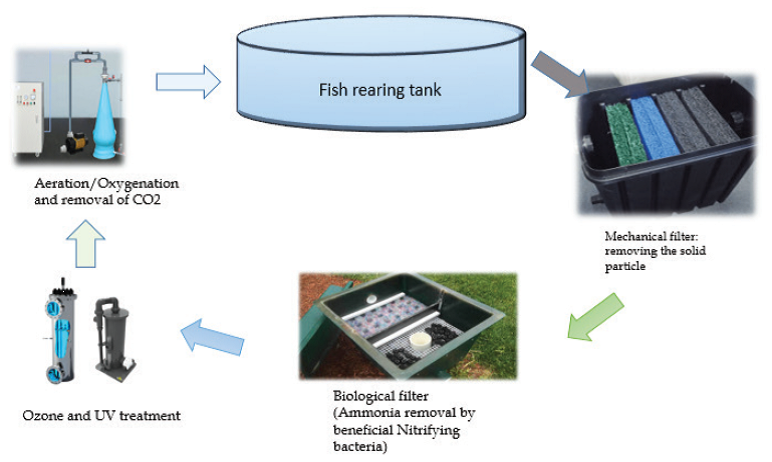Recirculatory Aquaculture System (RAS)
Recirculatory Aquaculture System (RAS)
Introduction
Recirculatory Aquaculture System (RAS) is a technology where water is recycled and reused after mechanical and biological filtration and removal of suspended matter and metabolites. This method is used for high- density culture of various species of fish, utilizing minimum land area and water.
It is an intensive high density fish culture unlike other aquaculture production systems. Instead of the traditional method of growing fish outdoors in open ponds and raceways, in this system fish are typically reared in indoor/outdoor tanks in a controlled environment. Recirculating systems filter and clean the water by recycling it back to fish culture tanks. The technology is based on the use of mechanical and biological filters and the method can be used for any species grown in aquaculture. New water is added to the tanks only to make up for splash out, evaporation and that used to flush out waste materials. The reconditioned water circulates through the system and not more than 10% of the total water volume of the system is replaced daily. In order to compete economically and to efficiently use the substantial capital investment in the recirculation system, the fish farmer needs to grow as much fish as possible in the inbuilt capacity. The management of recirculating systems relies heavily on the quantity and quality of feed and the type of filtration. Numerous filter designs are used in recirculating systems, but the overall goal of all filtration is to remove metabolic wastes, excess nutrients, and solids from the water and provide good water quality for the aquatic organisms. It is important to consider all factors when designing and investing in aquaculture systems.
However, in order to encourage small-scale fish farmers and entrepreneurs and also to facilitate fish production in urban and semi-urban areas where land and water are scarce, it is proposed to promote Backyard Recirculation Aquaculture Systems.
How RAS Works

Advantage of RAS
- Extended durability of tanks and equipment
- Reduced dependency on antibiotics and therapeutants hence, advantage of getting high quality fish.
- Reduction of direct operational costs associated with feed, predator control and parasites.
- Potentially eliminate release of parasites to recipient waters.
- Risk reduction due to climatic factors, disease and parasite impacts
- RAS production can promote flexibility in terms of location for farming, proximity to market.
- Enable production of a broad range of species irrespective of temperature requirements.
- Feed management is considerably enhanced in RAS when feeding can be closely monitored for 24 hrs.
- Exposure of stock to stress on RAS can be reduced for some factors such as adverse weather, unfavourable temperature conditions, external pollution and predation.
- Enable secure production of non-endemic species.
- Judicial use of water and land areas
Disadvantage of RAS
- Constant uninterrupted power supply is required if electric power fails than backup of electricity is required
- Capital cost of starting a recirculating aquaculture system is high as compared to ponds and raceways.
Species suitable for RAS
- Baramundi/ Asian Seabass/Bhetki (Lates calcarifer)
- Cobia (Rachycentron canadum)
- Silver/Indian Pompano (Trichinotus Blochii/ Trichinotus mookalee)
- Tilapia (Oreochromis niloticus)
- Pearl spot/Karimeen (Etroplus suratensis)
- Pangasius (Pangasianodon hypophthalmus)
- Rainbow Trout (Oncorhynchus mykiss), especially in Hilly/cold water Region
Components of RAS
- Insulated shed/ Building
- Store cum office for feed and accessories
- Pump house
- Grow out tanks: Circular cement tanks/ FRP tanks, including inlet, outlet central drainage
- Settling tanks for sludge
- Water Storage (sump) tanks
- Overhead tanks.
- Mechanical (Hydraulic) filters, Drum filter, Glass wool/ muslin cloth filter
- Pumps and motors
- Power generator
- Sludge collector, settelable/ solid collectors
- Biofilters, UV units
- Electrification
- Automatic feeder (wherever required)
- Aeration system (air/ oxygen), Carbon dioxide trapper system (degasser)
- Water testing kit
- Water supply system, bore well etc. (wherever required)
- Inputs such as Seed, Feed, additives and supplements, electricity/ Diesel, man power etc.
Feed
- A high protein feed, containing all the essential minerals and vitamins
- Species specific feed
- Feeding can be done @ 3-5 % of the body weight of the fish depending on the quality and protein content of feed.
- More frequent feedings (several times per day) shall result in better growth rates and thus improved feed conversion ratio.
For More Information Click Here
Source : National Fisheries Development Board
Last Modified : 9/14/2023
ICAR-Central Institute of Fisheries Technology COV...
This topic provides information about Trout Cultur...
Provides summary of District Agriculture Plan Wash...
This topic provides information about Trout Cultur...
